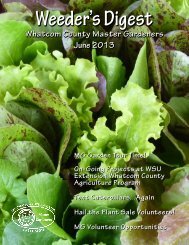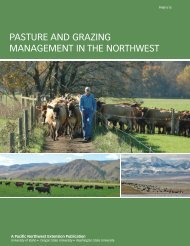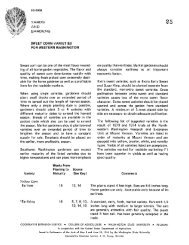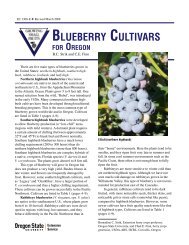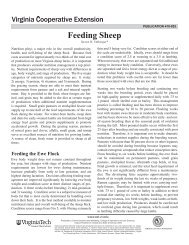May - WSU Whatcom County Extension - Washington State University
May - WSU Whatcom County Extension - Washington State University
May - WSU Whatcom County Extension - Washington State University
- No tags were found...
Create successful ePaper yourself
Turn your PDF publications into a flip-book with our unique Google optimized e-Paper software.
Weeder’s DigestPlant of the Month............................ By Cheryll Greenwood KinsleyCannaFamily: Cannaceae(Canna family)Genus: CannaLily-of-the-valley—Convallaria majalis—is the “official” plant for the month of <strong>May</strong>. But thisyear, let’s think larger and bolder. Much larger and much bolder.Recently I’ve been bitten by the summer-bulb bug, for reasons that aren’t entirely clear, even tome. Perhaps it’s because I want to explore yet another new aspect of gardening. But it’s also apractical way to deal with some bare spots in the garden—particularly in places where Ihaven’t yet hit on the specific plant I want to install as a permanent resident. Bulbs are easyand quick to put in and practically grow themselves—and here, I’m using the catchall term“bulb” to include rhizomes, corms, tubers, and tuberous roots. So for summer color I canchoose from begonias, lilies, and gladiolus—and dahlias, of course. I leave the growing of thelatter to Dick Porter. For years I’ve also eschewed lilies and glads. And cannas I wouldn’teven consider. But this year, inexplicably, I’m fascinated with them all—especially canna lilies.<strong>May</strong>be it’s all the times I’ve admired them in Peace Arch Park while waiting in line to cross theborder. Or it might be distant memories of old gardens I knew as a child. Didn’t all our grandmothersgrow “common” red cannas?At last count, the genus Canna—the only one in the Cannaceae family—included 55species indigenous to the tropics and now naturalized around the world. Canna edulis isnative to South America, where its fleshy rhizomes are a food source. They’re dried andpulverized into what’s called tous les mois in France and “arrowroot flour” in Britain—although the arrowroot we use here in cooking as a thickener comes from Marantaarundinacea, another plant entirely. The seeds of several canna species are used to makejewelry, because they’re very hard and uniformly shaped. It’s rumored they served as asubstitute for lead shot in flintlock muskets during the 18 th and 19 th centuries.The canna lily is a perennial grown from a rhizome, just like the lily-of-the valley. Thetwo plants are otherwise unrelated, although the large leaves of the canna do resemble thetiny leaves of the lily-of-the-valley, in form if not in color or size. Linnaeus categorized Canna indica—and he didn’t use leaves so much as the reproductive parts of flowers to organize his classifications.The Canna flower has one stamen and one pistil, which placed it in the Monandria class and theMonogynia order. The word “canna” is from the Latin for “cane” or “reed,” and Linnaeus named thatfirst species he saw after what he thought was its country of origin—India.What our grandmothers grew might have been Canna indica. It’s actually a New World nativeand grows in the wild throughout the Caribbean and Pacific islands, where it’s on the verge of beingdeclared a nuisance. It’s unlikely to take hold to that degree in our area. An enormous number of namedvarieties are now available for our home gardens, and show-stopping they can be. Choose yourscarefully. There are cannas with small flowers and others with very large flowers, in a range of brilliantcolors. The foliage varies from variety to variety and is frequently as extraordinary as the flowers. Youmay actually have to depend on the foliage for effect rather than on the flowers, because cannas bloomlate in what they hope will be a hot summer. They may be slow to blossom here, in any given year, andmay not come into their own until the weather is too cool to sustain them. Where they do get a greatdeal of heat, some varieties can top out at almost fifteen feet, but you’re unlikely to see that here in ourcool-summer climate. Those that are full-size may make it to five feet. If even that’s too much height forthe space you have available, select one of the many dwarf varieties. You’ll get the same great flowersand almost as many outstanding foliage choices, but on plants that are only two or three feet high.Plant your canna rhizomes before the middle of <strong>May</strong> in the richest, most moisture-retentive soilyou can manage, where they’ll get full sun. Place them about four inches deep and eighteen inchesapart—eyes up if you can find them, but don’t worry if you can’t. Just lay the rhizomes in the groundhorizontally. Cannas are heavy feeders, so add some fertilizer according to package directions when youplant and at monthly intervals during the summer. Use a complete, balanced formulation or—better—one that goes easy on the nitrogen. Avoid feeding cannas excess amounts of this particular nutrient, somake sure that first number is not greater than the other two. All cannas need at least some moistureadministered regularly. Read up on your varieties to learn their specific requirements. Some are actuallybog plants and will thrive along the shallow edges of ponds. Others are marginal, and appreciate wetfeet. Many will do fine with a weekly deep soak.Watch for slugs when the shoots emerge, and keep checking through the growing season. Weknow our abundant slug population has quite a taste for things succulent and tropical! Then standback. When late summer rolls around, you’ll appreciate the “bold” move you took in <strong>May</strong>.





